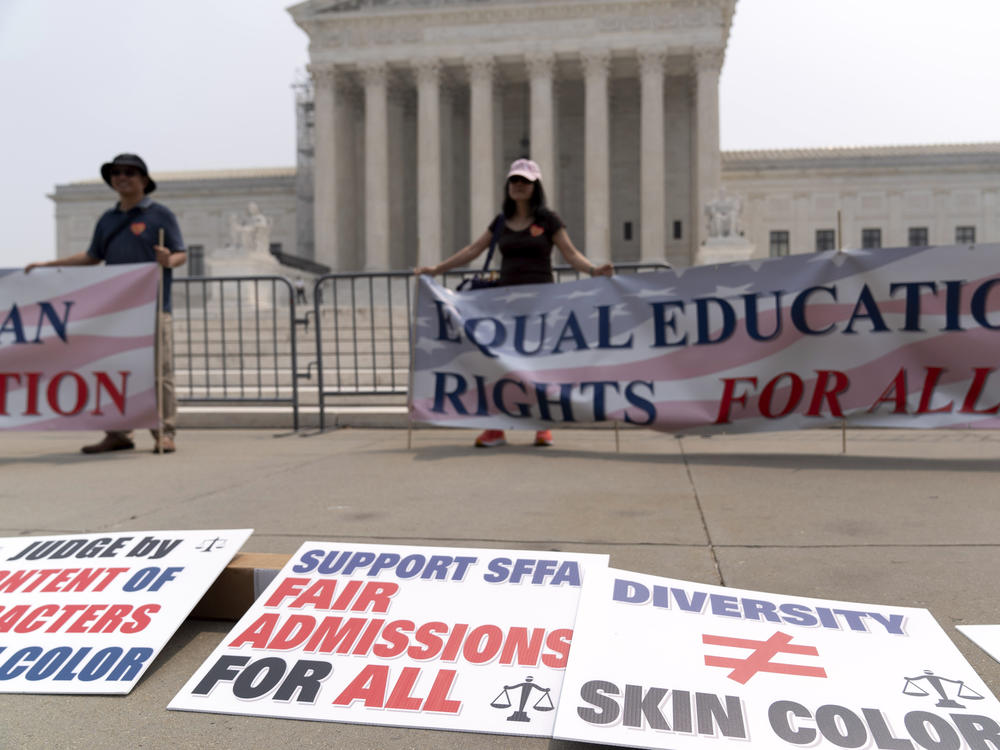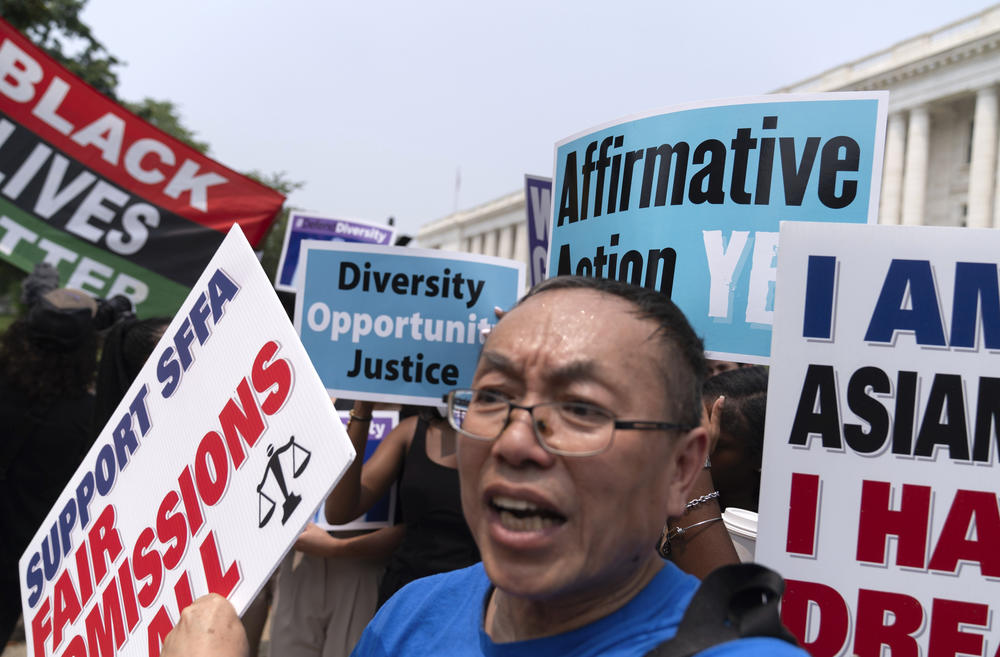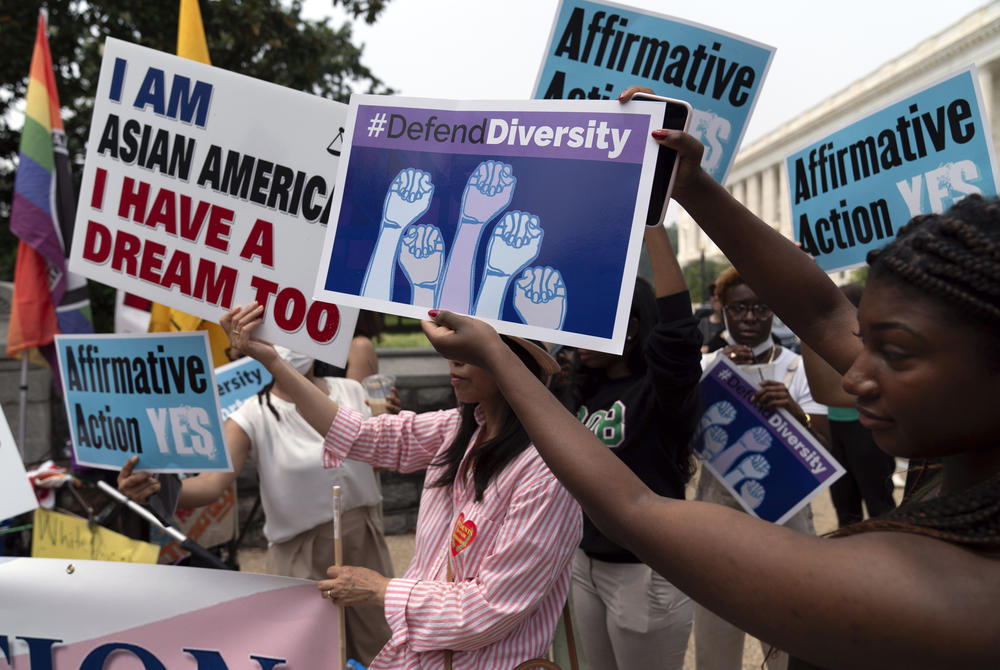Section Branding
Header Content
Affirmative action divided Asian Americans and other people of color. Here's how
Primary Content
In 2015 Edward Blum, the conservative activist behind the push to end affirmative action, stood in front of a group of a dozen or so mostly Chinese Americans in a conference room in Houston.
He was introduced by the Houston Chinese Alliance's David Cao, who prefaced Blum's presentation with a quote from George Orwell's novella Animal Farm.
"All animals are equal, but some animals are more equal than others," Cao said, to a smattering of laughter.
"In admission to the American elite universities, it is no secret that Asians are less equal."
But Blum was trying to change that, Cao told the group.
Blum is not a lawyer but according to the American Civil Liberties Union, he has a "long history of crafting legal attacks on civil rights."
He helped orchestrate Shelby County v. Holder, the Supreme Court ruling that rolled back voting rights, making it harder for ethnic minorities to vote. And he's been laser focused on eliminating the use of race and ethnicity in college admissions.
Blum had first cast two white women, most notably Abigail Fisher, to craft lawsuits intended to end affirmative action. Fisher claimed she didn't get into the University of Texas, Austin because of the color of her skin. Affirmative action, the argument went, was racist against white people. Fisher was an innocent victim unfairly losing out to people of color.
A closer look at the evidence found that race likely played no role in Fisher's rejection and in the end the cases she served as the face of failed.
But Blum was already looking to cast a new face in the role of affirmative action's victim. This time it wouldn't be a white one.
"I needed plaintiffs," he told the group gathered by the Houston Chinese Alliance in 2015. "I needed Asian plaintiffs."
This was a deliberate switch in strategy, says Ian Haney López, a race and constitutional law scholar at Berkeley. The argument was no longer centered on how affirmative action impacts white people — instead, "There's this move to strengthen the surface argument that this is racism against minorities," Haney López says.
"I think that's part of the appeal."
"Asians were standing in as proxies for white students," says Jeff Chang, a writer and activist who has long fought for affirmative action. "That's essentially the strategy that Ed Blum used."
That strategy, before a far right Supreme Court, would finally be a winning one for Blum. But to reach this goal, scholars like Chang say he and his colleagues pitted Asian Americans against Black and Latino communities, using both real issues and false narratives, to end policies that had helped diversify college campuses.
"In the case of university admissions over the past decade, Asians serve as this sort of mask for white privilege," Chang says. "A mask that white privilege can wear in order to hide itself." A mask, he says, with the veneer of very real experiences of racism by Asian Americans.
"Is anti-Asian racism real? Yeah, absolutely," says OiYan Poon, a professor at Colorado State University who studies race-based admissions. "I have experienced it firsthand."
But according to her research, affirmative action is not the source of that racism.
"I've been pouring over the data for years," she says — including the admissions data of Harvard before the court in one of the case that just ended affirmative action. "There is no evidence that there's a practice of anti-Asian discrimination."
Still a combination of real feelings of racial marginalization paired with personal experiences of children and students not getting into a very few spots at a very elite college, helped Blum tap into a narrative that affirmative action was targeting Asian Americans; that they were "less equal."
"Predominantly white, conservative political forces are leveraging this experience of being racially marginalized among Asian Americans to say, yeah, and by the way, there's this policy that you're not benefiting from," Poon says.
"It's really tapping into fear with zero evidence."
"I feel like Asian Americans have been used"
The irony is that Asian Americans have long been treated as less equal in American education, Chang says.
In 1978 the Supreme Court eliminated the use of the quota system on college campuses, which included set aside seats for Asian Americans, in what some scholars see as an initial blow to repairing long legacies of discrimination and segregation. But the court left open the possibility for schools to consider race as a factor in their admissions process, for the sake of campus diversity.
Chang was a student at Berkeley, part of a cohort of students fighting against Asian American exclusion in the decade after, in the 1980s. (This was before California's 1996 ban on affirmative action created a steep drop off in Black and Latino students on University of California campuses).
Chang says when he was at Berkeley there was evidence schools were purposefully suppressing Asian American admission — not because those seats were going to Black or Latino students, but because they were going to white ones.
"We were able to get the University of California to actually admit that they had discriminated against Asian Americans by dis-advantaging them in what we're supposed to be head-to-head, merit-based types of competitions between Asian and white students," Chang says.
Chang says he can't help but notice that Blum and his supporters borrowed, even co-opted, their movement and their message, along with some of their legal strategies, but for the exact opposite ends. Instead of fighting for affirmative action, they were fighting to kill it.
The group Chang co-founded in 1987 was called the Student Coalition for Fair Admissions.
When Blum founded his organization in 2014 he called it Students for Fair Admissions, or SFA.
But for one word, it was an exact copy of the name of the organization Chang co-founded.
But the missing word — coalition — is a key one. Chang's group was founded and filled with Asian American students and activists. Blum's group, on the other hand, was founded by a white man and "never produced any students who were discriminated against as they had in the Fisher case," Chang says. Some students have spoken out in the media, but none have testified in court.
"They've spoken on our behalf and they've erased our history," Chang says about Blum's SFA.
"I feel like Asian Americans have been used."
Myth of affirmative action harming Asian Americans creates "deliberate racial wedge between communities of color"
Jeff Wang, whose son Michael was a poster child for Asian students against affirmative action after he was rejected from several elite collages, agrees that decades ago many Asian Americans needed the leg up provided by race conscious admissions.
But he says, times have changed. "Now we see disadvantaged groups like Asians — like Chinese, like Indians, they are minorities and their rights are being taken away."
That, he says, "makes affirmative action more complicated."
"Asians and African Americans and Latinos — we live in the same community. We don't want it divided," he says. "This is not a case of Asian Americans win and African Americans and Latinos lose."
Except the inverse of that equation lives just beneath the surface of Asian American opposition to affirmative action.
One of the students behind SFA's lawsuit who has come forward to tell his story in recent weeks is Jon Wang (no relation to Jeff Wang). He spoke with Fox news, sharing a by now familiar narrative of being rejected from six elite schools, despite being a perfect student on paper, with stellar grades and test scores.
Wang said he was told by friends and guidance counselors that his Asian identity was a liability.
"They all told me that it's tougher to get in, especially as an Asian American. I just took it as gospel."
Wang was accepted at Georgia Tech, a highly ranked school. Still, he turned to Blum's Student's for Fair Admissions for answers about the schools that had rejected him.
"I gave them my test scores and a few other things about me, and then they must have ran the model on that," he said.
"And then Edward Blum told me my results, and so they said I had a 20% chance of getting admission to Harvard as an Asian American, and then a 95% chance as an African American" he told Fox.
The framing here is clear, says Sally Chen with the group Chinese for Affirmative Action. Asian American rejection is directly tied to Black acceptance.
"This myth of affirmative action being harmful to Asian Americans is creating a deliberate racial wedge between communities of color," she says.
"It's ultimately rooted in anti-Blackness."
While SFA produced no students to testify against affirmative action in their trials, Chen was one of eight Asian American students — current and former — who spoke on behalf of Harvard and affirmative action.
"Pitting Asian American communities against, in particular, Black and Latinx communities," Chen says, "is about undermining the accomplishments of a lot of Black and Latinx students."
There is a common narrative that Black and Latino students who were admitted into schools like Harvard and University of North Carolina are not qualified, not ready to succeed in college.
"We cannot deny that," says Jeff Wang. "Because we see that African American and Latinos, their graduation rates are lower because they were not fully prepared."
But according to the U.S. Department of Education in 2021, Black Harvard students had a 96% graduation rate — the same graduation rate that male students of all races had. Hispanic students rate that same year was 97% — the same as white students.
At the University of North Carolina, the graduation rate was 85% for Black students, 91% for Latinos, 92% for white students and 94% for Asian Americans.
A recent Gallup poll found that Black and Latino students are more at risk for dropping out, not because they aren't capable or prepared.
They leave because they are caretakers for children, parents, or other family members. Then there is the issue of money, and the burdens of student debt. Another reason? Many students of color can feel psychologically unsafe. Majority-white campuses can be isolating and even toxic to underrepresented students — something that the likely drop in Black and Latino students post affirmative action will only make worse, says Sally Chen.
"Attacking their belonging at these educational institutions stokes fear of scarcity, a sense of fighting over crumbs, when ultimately the solutions we need are to expand the pie," she says.
Chen points out this divide and conquer strategy among communities of color is nothing new. It's deeply familiar to anyone who understands the model minority myth.
The promise of proximity to whiteness and power has radicalized some Asian Americans on the right
That myth posits that Asian Americans are a "good" minority group — assimilating and bootstrapping themselves into the American dream. "It's been used historically to undermine other non-white groups pressing for justice," says Janelle Wong, director of Asian American studies at the University of Maryland.
"It's been used to compare other groups to Asian Americans without any context to say, well, 'this non-white group, Asian Americans, can succeed. So why can't Black or Latino groups?' "
Wong says "it ignores that Asian Americans have been selectively recruited via U.S. immigration," while also overlooking the particular history and ongoing systemic racism that specifically impacts Black Americans.
"In a society in which there is a powerful violent hierarchy of white people over Black people, where am I in that hierarchy?" says Ian Haney López. "It's very common for people to look at that hierarchy and say, let me not be at the bottom."
For non European immigrants, there is always this painful decision of how to best to be accepted in America. "It's not uncommon for people not of European descent to say, 'I'm gonna claim access to the white side of the color line.' "
"That's the dynamic that Blum is trading on," Haney López says. He says the promise of proximity to whiteness and power has been used as part of a larger trend radicalizing Asian Americans on the right. "He's saying — 'hey Asian Americans, you too can see Black and brown people demanding equity and inclusion as a threat to you. Cast your fate with white opponents of integration, with white people who are skeptical of equality.'"
Research about the model minority myth bears this out, Wong says. "Asian-Americans who internalize this myth are also more likely to exhibit anti-Black attitudes and to be anti-affirmative action."
The model minority myth does something else, Chen says. By bolstering the idea that Asian Americans—like her—don't benefit from race conscious policies or practice, "it insinuates that Asian Americans are not affected by racism in this country."
"We lose so much of the information we need about where our communities are hurting," she says.
Affirmative action for the white and wealthy
Some proponents of affirmative action agree that there are legitimate questions about whether or not Asian American admission numbers continue to be suppressed at some elite universities.
Sally Chen says that a pattern of lower personality ratings for Asian American applicants indicates pervasive racism and implicit bias. "There is a need for anti-bias training for specifically admissions readers that read Asian American student files," she says.
"There's a lot of room for improvement in this process. But none of that is accomplished through the flat removal of race in educational settings."
Chen even agrees that some Asian American students may be losing spots to less qualified students. But she says, those students are white.
A 2019 study found almost half — 43% — of white students who got into Harvard did so because they have legacy connections, their parents have donated large sums of money, or they are student athletes — often, as seen in the Varsity Blues scandal — in very specific and expensive sports. (Sports like sailing or tennis, not necessarily the kind offered at your local public school).
The study concluded that "removing preferences for athletes and legacies would significantly alter the racial distribution of admitted students, with the share of white admits falling and all other groups rising or remaining unchanged."
This is affirmative action for the white and wealthy, Chen says. "There is really a thumb on the scale for people who have always had access to these spaces."
But that's not the target of SFA and Blum's lawsuit, Chen says. Instead they are going after policies put in place to help correct that imbalance.
In response to a question asking if his actions are racist or bigoted, Blum told CBS News' Sunday Morning that "I think that's an easy, intellectually lazy way of making an argument."
"It's unclear who this is going to advantage," he said of his successful quest to end affirmative action.
There is already a test case for ending affirmative action to be found in California's UC system. Black and Latino enrollment sharply declined.
Experts and activists like Jeff Chang and OiYan Poon say contrary to Blum's claims, it is very clear who dismantling affirmative action will advantage — those who've always been "more equal" in American education, people with access to wealth and privilege.
When David Cao introduced Edward Blum to Asian Americans in Houston almost a decade ago, he quoted Orwell's famous line from Animal Farm, that all animals are equal, but some are more equal.
But Poon says that doesn't describe a world with affirmative action; it better sums up our education system without it.
"To think like somebody like Ed Blum is gonna come along and basically bamboozle young Asian Americans into thinking like these policies are against us when they're actually for us is just heartbreaking," she says.
Poon acknowledges affirmative action was always an incomplete solution — a band aid over systemic racism that never addressed systemic causes. But the band aid has been ripped off, and at least for now, advocates fear, there is nothing to stop the bleeding.
Copyright 2023 NPR. To see more, visit https://www.npr.org.



